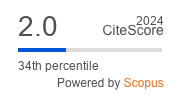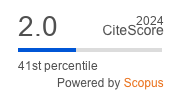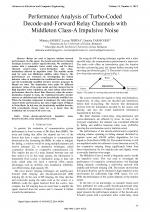| 4/2014 - 6 |
Performance Analysis of Turbo-Coded Decode-and-Forward Relay Channels with Middleton Class-A Impulsive NoiseANDREI, M. |
| Extra paper information in |
| Click to see author's profile in |
| Download PDF |
Author keywords
decode-and-forward, impulsive noise, iterative decoder, relay channels, turbo codes
References keywords
communications(9), turbo(6), noise(6), cooperative(6), channel(6), relay(5), performance(4), impulsive(4), decode(4), coded(4)
Blue keywords are present in both the references section and the paper title.
About this article
Date of Publication: 2014-11-30
Volume 14, Issue 4, Year 2014, On page(s): 35 - 42
ISSN: 1582-7445, e-ISSN: 1844-7600
Digital Object Identifier: 10.4316/AECE.2014.04006
Web of Science Accession Number: 000348772500006
SCOPUS ID: 84921649589
Abstract
Relays are used to improve wireless network performances. In this paper, the decode-and-forward relaying technique is used to achieve spatial diversity. We considered a system with a symmetric turbo coded relay and its three channels (source-relay, source-destination and relay-destination) affected by impulsive noise. The statistic model used for noise was Middleton additive white Class-A. The performances are evaluated by investigating the system behavior when at destination the traditional iterative decoder and the heuristically modified iterative decoder proposed by Huynh are used. The simulations were made for different parameter values of the noise model and they showed that in high impulsive noise conditions, the relay system offers better performance than the direct link. However, when the source-destination channel is weak, the traditional iterative decoder assures an additional gain than the heuristically modified one. When the Gaussian component is dominant, the relay system ensures better performances, but only at high values of Signal-to-Noise Ratio. In this case, the heuristically modified decoder, with conveniently chosen value for alpha, is better than the traditional one in terms of bit error rate. |
| References | | | Cited By «-- Click to see who has cited this paper |
| [1] V. Tarokh, N. Seshadri and A.R. Calderbank, "Space-time codes for high data tare wireless commnunication: Performance criterion and code construction", IEEE Transactions Information Theory, vol. 44, no. 2, pp. 744-765, March 1998. [CrossRef] [SCOPUS Times Cited 6105] [2] A. Nosratinia, T.E. Hunter and A. Hedayat, "Cooperative communication in wireless networks", IEEE Communications Magazine, vol. 42, no.10, pp. 74-80, Oct. 2004. [CrossRef] [SCOPUS Times Cited 2676] [3] K.J.R. Liu, A.K. Sadek, W. Su and A. Kwasinski, Cooperative Communications and Networking, Cambridge University Press, Cambridge, 2009. [4] M. Ju and L.-M. Kim, "Error Performance analysis of BPSK Modulation in Psysical-Layer Network-Coded Bidirectional Relay Networks", IEEE Transactions on Communications, vol. 58, no. 10, pp. 2770-2775, Oct. 2010. [CrossRef] [SCOPUS Times Cited 131] [5] S. Ghadimi, J. Hussian, T. S. Sidhu, S. Primak, "Effect of Impulse Noise on Wireless Relay Channel", Wireless Sensor Network, vol. 4, no.6, pp. 167-172, June 2012. [CrossRef] [6] J. N. Laneman, Cooperative diversity in wireless networks: Algorithms and architectures, pp. 79-109, PhD Thesis, Massachusetts Institute of Technology, Cambrige, M.A., Aug. 2002. [7] B. Zhao and M.C. Valenti, "Distributed turbo coded diversity for relay channel", Electronics Letters, vol. 39, no. 10, pp. 786-787, May 2003. [CrossRef] [SCOPUS Times Cited 319] [8] K. Ho Van and T. Le-Ngoc, "Performance of Decode-and-Forward Cooperative Relaying over Rayleigh Fading Channels with Impulsive Noise", in Proc. International Conference on Advanced Technologies for Communications (ATC), pp. 183-188, Oct. 2010. [CrossRef] [SCOPUS Times Cited 3] [9] H. Van Khuong and T. Le-Ngoc, "Effect of Impulsive Noise on Decode-and-Forward Cooperative Relaying over Fading Channel", in Proc. IEEE Wireless Communications and Networking Conference (WCNC), pp. 1392-1397, March 2011. [CrossRef] [SCOPUS Times Cited 3] [10] S. Al-Dharrab and M. Uysal, "Cooperative Diversity in the Presence of Impulsive Noise", IEEE Transactions on Wireless Communications, vol. 8, no. 9, pp. 4730-4739, Sept. 2009. [CrossRef] [11] K.Q. Huynh and A. Tor, "Improved Iterative Decoders for Turbo-Coded Decode-and-Forward Relay Channels", in Proc. IEEE Vehicular Technology Conference (VTC Fall) , Sept. 2012. [CrossRef] [SCOPUS Times Cited 3] [12] D. Umehara, H. Yamaguchi and Y. Morihiro, "Turbo Decoding over Impulse Noise Channel", International Symposium on Power Line Communications ISPLC 2004, Zaragosa, Spain, 2004. [13] N. Andreadou and F.-N. Pavlidou, "PLC Channel: Impulsive Noise Modeling and Its Performance Evaluation Under Different Array Coding Schemes", IEEE Transactions on Power Delivery, vol. 24, no. 2, pp. 585-595, April 2009. [CrossRef] [SCOPUS Times Cited 60] [14] A. Savin and L. Trifina, "Component Recursive Systematic Convolutional Code Analysis in a Symetric Turbo-Coded Decode-and-Forward Relay Channel", Bulletin of the Polytechnic Institute of Jassy. Electrical Engineering, Power Engineering, Electronics, vol. LIX (LXIII), no. 2, pp. 35-44, 2013. [15] L.R. Bahl, J. Cocke, F. Jelinek and J. Raviv, "Optimal Decoding of Linear Codes for Minimizing Symbol Error Rate", IEEE Transactions on Information Theory, vol. 20, nr. 2, pp. 284-287, March 1974. [CrossRef] [SCOPUS Times Cited 5218] [16] P. Robertson, E. Villebrun and P. Hoecher, "A Comparison of Optimal and Sub-Optimal MAP Decoding Algorithms Operating in the Log Domain", in Proc. IEEE International Conference on Communications ICC'95, Seattle, WA., vol. 2, pp. 1009-1013, June 1995. [CrossRef] [17] J. Vogt and A. Finger, "Improving the max-log-MAP turbo decoder", Electronics Letters, vol. 36, no. 23, pp. 1937-1939, Nov. 2000. [CrossRef] [18] D. Divsalar and F. Pollara, "Turbo Codes for PCS Applications", in Proc. IEEE International Conference on Communications ICC'95, Seattle, WA., vol. 1, pp. 54-59, June 1995. [CrossRef] Web of Science® Citations for all references: 0 SCOPUS® Citations for all references: 14,518 TCR Web of Science® Average Citations per reference: 0 SCOPUS® Average Citations per reference: 764 ACR TCR = Total Citations for References / ACR = Average Citations per Reference We introduced in 2010 - for the first time in scientific publishing, the term "References Weight", as a quantitative indication of the quality ... Read more Citations for references updated on 2025-07-01 16:44 in 94 seconds. Note1: Web of Science® is a registered trademark of Clarivate Analytics. Note2: SCOPUS® is a registered trademark of Elsevier B.V. Disclaimer: All queries to the respective databases were made by using the DOI record of every reference (where available). Due to technical problems beyond our control, the information is not always accurate. Please use the CrossRef link to visit the respective publisher site. |
Faculty of Electrical Engineering and Computer Science
Stefan cel Mare University of Suceava, Romania
All rights reserved: Advances in Electrical and Computer Engineering is a registered trademark of the Stefan cel Mare University of Suceava. No part of this publication may be reproduced, stored in a retrieval system, photocopied, recorded or archived, without the written permission from the Editor. When authors submit their papers for publication, they agree that the copyright for their article be transferred to the Faculty of Electrical Engineering and Computer Science, Stefan cel Mare University of Suceava, Romania, if and only if the articles are accepted for publication. The copyright covers the exclusive rights to reproduce and distribute the article, including reprints and translations.
Permission for other use: The copyright owner's consent does not extend to copying for general distribution, for promotion, for creating new works, or for resale. Specific written permission must be obtained from the Editor for such copying. Direct linking to files hosted on this website is strictly prohibited.
Disclaimer: Whilst every effort is made by the publishers and editorial board to see that no inaccurate or misleading data, opinions or statements appear in this journal, they wish to make it clear that all information and opinions formulated in the articles, as well as linguistic accuracy, are the sole responsibility of the author.



